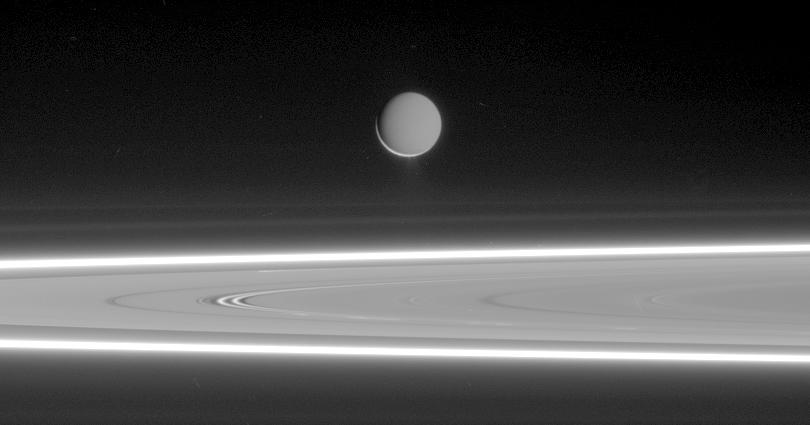
“We must believe then, that as from hence we see Saturn and Jupiter; if we were in either of the Two, we should discover a great many Worlds which we perceive not; and that the Universe extends so in infinitum.”
— Cyrano de Bergerac, “A Voyage to the Moon” (1656)
In his “Voyage to the Moon,” which is considered one of the best examples of early science fiction, 17-century French satirist and dramatist Cyrano de Bergerac satirized the politics and religious beliefs of his day, while also contemplating an infinite Universe that was populated with an infinite number of worlds. Taking a cue from this fictional story, NASA’s Voyager, Galileo, and Cassini missions have helped to reveal more than 300 years later the true magnificence and beauty of the moon systems of all the gas giant planets in the outer Solar System, while also opening our eyes to the intriguing possibility for life on some of these fascinating worlds. The second part of this article focused on Jupiter’s moon Europa, whose underground ocean is considered a potential cradle for life. Yet even more equally fascinating worlds await us as we journey farther out in the Solar System. Approximately a billion and a half kilometers from the Sun, two of Saturn’s 62 moons, Enceladus and Titan, are also intriguing astronomers with their potential to host potentially habitable environments.
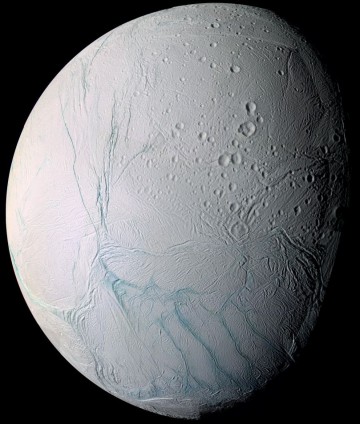
The first robotic mission to explore Saturn and return humanity’s first-ever close-up images of the ringed planet and its moons was Pioneer 11, which flew within 21,000 km of the planet’s cloud tops in September 1979. By that time NASA had already launched its follow-up twin Voyager 1 and 2 spacecraft toward the outer Solar System, which conducted a much more detailed exploration of Saturn and the other gas giant planets during the next decade. One of the major scientific targets for both spacecraft was enigmatic Titan, a moon of Saturn that is enshrouded in a thick, hazy atmosphere that entirely obscures its surface and is one of the prime targets in the Solar System for the search for alien life. Unfortunately, both Voyager spacecraft weren’t equipped with the necessary instruments that could allow them to penetrate Titan’s thick atmosphere and peer behind its hazy veil. Nevertheless, they were both able to photograph most of Saturn’s other moons in great detail, including Enceladus, a small 500-km-wide rocky world orbiting inside the tenuous E ring at the edges of Saturn’s extensive ring system. The images of Enceladus, in particular, revealed a world with a highly reflective and fractured surface covered in water ice. One of Enceladus’ most striking characteristics, as revealed by the Voyagers, was that its surface featured a multifaceted terrain that was a mix of geologically old, heavily cratered plains and surprisingly young and smooth crater-free areas which were crisscrossed by a network of cracks, ridges, and grooves. Yet, as detailed as the Voyager images were, they lacked the necessary resolution to offer more clues as to the geology, history, and evolution of these fascinating worlds.
An icy hot spot for life?
It wasn’t until the arrival of NASA’s Cassini–Huygens spacecraft on Saturn in July 2004 that the scientific community and the public alike could experience the splendor and exquisite beauty of the Saturn system in all its glory, through Cassini’s unique views of the planet’s majestic ring system, atmosphere, and system of moons that could be best characterized as a fusion of science and art.
One of the highlights of Cassini’s historic mission, which recently celebrated its 10th anniversary in orbit around the ringed planet, proved to be the exploration of Enceladus. A few months after entering into orbit around the planet, Cassini paid its first visit to the small moon in February 2005 while approaching it at a distance of 1,167 kilometers. Right from the start, Enceladus proved to be an exciting and mystifying world. During the flyby, Cassini’s onboard Magnetometer instrument found that the magnetic field lines of Saturn’s magnetosphere, inside which Enceladus’ orbit lies, were found to be deflected by the moon near its surface. If Enceladus was an airless body, as was originally envisioned, then Saturn’s magnetic field lines should reach all the way to the moon’s surface. Yet Cassini’s magnetometer revealed that the former were slowed down near Enceladus and were wrapped around the moon instead. In addition, the spacecraft detected oscillations of ionized water vapor around Saturn’s magnetic field lines in Enceladus’ vicinity, leading to a surprising but inescapable conclusion which was confirmed during a series of follow-up flybys: This small Saturnian moon featured a sizeable localised atmosphere around its south polar region that consisted of more than 90 percent water vapor, with trace elements of nitrogen, methane, and carbon dioxide.
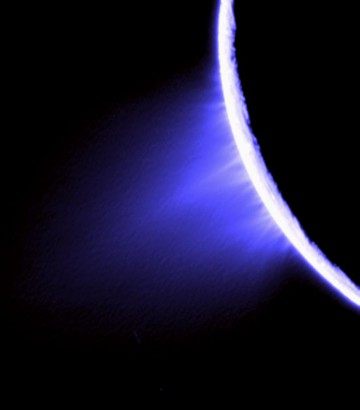
Since Enceladus is such a small world—approximately 10 times smaller than Saturn’s biggest moon Titan—its gravity is not strong enough to maintain such an atmosphere for long periods of time, leading scientists to speculate it is somehow replenished by the moon itself. This notion was confirmed in subsequent Cassini flybys during 2005, when the spacecraft’s onboard Ion and Neutral Mass Spectrometer and Cosmic Dust Analyzer instruments detected large peaks of water vapor and ice particles, respectively, coming from Enceladus’ south pole. Cassini’s onboard Imaging Science Subsystem provided complementary visual clues, revealing a series of plumes that extended high above Enceladus’s disk and replenished with fresh water ice particles not only the moon’s localized atmosphere but Saturn’s tenuous E ring as well. Additional images from the spacecraft’s cameras allowed the mission’s science team to identify the astonishing source of these alien fountain-like eruptions: A set of four parallel 130-km-long linear depressions, nicknamed the “tiger stripes,” were venting more than 200 kg of water ice, carbon dioxide, nitrogen, and methane every second, to heights of more than 100 km above the moon’s surface, at speeds of 7 km/s—an amazing discovery that caught scientists completely off-guard. “Never did we expect that we were gonna see something like a whole forest of jets shooting hundreds of kilometers into the sky above Enceladus,” says Dr. Carolyn Porco, planetary scientist and leader of Cassini Imaging Team. “It was like nothing we had ever seen before.”
These geological formations proved to be much hotter than their surroundings as well. When Cassini flew above Enceladus’ south polar regions again in July 2005, it took temperature measurements with its onboard Composite Infrared Spectrometer. The instrument recorded temperatures around the tiger stripes as high as -116 degrees Celsius. This would hardly qualify as “hot” by any terrestrial standards, yet on Enceladus, where the average surface temperature is -198 degrees, these measurements meant that there was a huge amount of excess heat coming from the south polar region. “This is as astonishing as if we’d flown past Earth and found that Antarctica was warmer than the Sahara,” says Dr. John Spencer, an astronomer at the Southwest Research Institute in Boulder, Colo., and member of the Composite Infrared Spectrometer science team. The line of evidence gathered during these early Cassini flybys eventually helped scientists to put the pieces together regarding Enceladus’ internal structure. The picture that emerged described Enceladus as a very geologically active world, which featured underground reservoirs of liquid water that were kept warm by tidal friction forces through the water’s contact with the moon’s rocky core. As the underground water found its way to the surface through the fissure openings of the tiger stripes, it quickly vaporized in the cold vacuum of space, forming the magnificent plumes that were observed for the first time by Cassini.
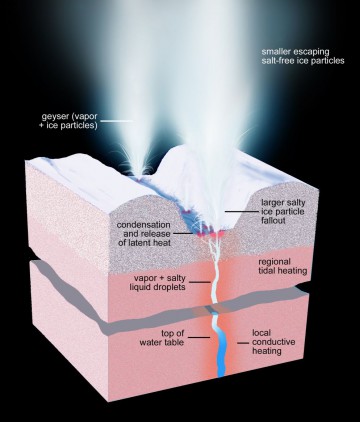
Yet theoretical models have shown that even though tidal friction most probably plays a role in the heating of Enceladus’ underground water reservoirs, it cannot explain the amounts of excess heat that has been observed coming off its south pole. Many possible mechanisms have been proposed throughout the years to account for the phenomenon, but Enceladus’ exact heating source still remains a mystery to this day. “One of the most fascinating aspects of Enceladus is that it is so very small as icy moons go, but so very geophysically active,” adds Dr. Robert Brown, a professor at the University of Arizona and member of Cassini’s Visual and Infrared Mapping Spectrometer. “It’s hard for a body as small as Enceladus to hold onto the heat necessary to drive such large-scale geophysical phenomena, but it has done just that.”
These astonishing and completely unanticipated findings cemented Enceladus as one of the few geologically active moons in the outer Solar System, besides Jupiter’s Io and Neptune’s Triton, while hinting at the possibility of an underground habitable environment. If Enceladus had liquid water and an energy source, could it also have a pre-biotic chemistry?
The answer to this question came during three flyby of Enceladus in 2008 and 2009 by Cassini, when scientists commanded the spacecraft to make a series of very low passes through the moon’s plumes in order to study their chemical composition with its onboard Ion and Neutral Mass Spectrometer and Cosmic Dust Analyzer instruments. Even though Cassini lacked the necessary instruments to detect any signs of biological activity in Enceladus’ water plumes, the latter’s spectra analysis excited the mission’s science team by revealing the presence of carbon monoxide and carbon dioxide, as well as basic organic compounds like propane, benzine, hydrogen cyanide, acetylene, and formaldehyde, which are the basic building blocks for life as we know it. “That was tremendously exciting to find, because not only do we think there’s liquid water there, not only is there an enormous amount of excess heat, but we also have organic materials,” says Porco. “And that’s the trifecta that we are looking for. The three main ingredients for a habitable zone.”
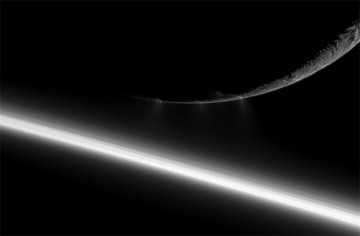
Furthermore, Cassini’s new thermal observations of the area around the tiger stripes found the latter to be more than 20 degrees hotter, compared to the initial measurements in 2005. These elevated temperatures, according to scientists, only strengthened the case for an underground liquid water ocean located on the moon’s south pole. Compelling evidence in support of this notion were provided in a study published in the journal Nature in 2011, which found that the ejected grains from Enceladus’ plumes were rich in sodium salts, strongly indicating a salty liquid water origin. But a definitive confirmation would have to wait until April of this year, when new findings based on gravity measurements from Cassini, published in the journal Science, showed that the south pole of Enceladus most probably harbors a 10 km-deep subsurface regional ocean, as detailed in a previous AmericaSpace article by Paul Scott Anderson—an ocean which gives rise to more than 100 geysers inside the moon’s tiger stripes region. “The Cassini gravity measurements show a negative gravity anomaly at the south pole that however is not as large as expected from the deep depression detected by the onboard camera,” says Dr. Luciano Iess, an associate professor at the Sapienza University of Rome and lead author of the study. “Hence the conclusion that there must be a denser material at depth that compensates the missing mass: very likely liquid water, which is seven percent denser than ice. The magnitude of the anomaly gave us the size of the water reservoir.”
An uncertain future
As significant as these discoveries by Cassini have been, they can’t answer the most important question of all: Despite the tantalising evidence pointing toward Enceladus’ habitability, does the moon harbor any life? The answer to this question is beyond the scope of Cassini’s instruments, one that requires a dedicated astrobiology mission to Enceladus that will specifically search for signs of biological activity. Even though Cassini itself will undoubtedly continue to make important discoveries in the Saturn system, it nevertheless faces a finite future. Having been granted a final three-year extension of science operations by NASA earlier this month the spacecraft will plunge into Saturn’s atmosphere in 2017 following the depletion of its fuel reserves, finally putting an end to a triumphant 20-year mission of discovery. When that time comes, it will leave a void in the exploration of the outer Solar System with no new mission currently scheduled for Saturn and its moons.
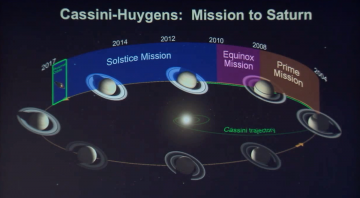
Based on the spectacular results that were returned by Cassini, the planetary science community has been advocating for years for a dedicated mission to Enceladus to study the moon’s potential for life in more detail and even return some samples from its water ice plumes back to Earth for further analysis. “To me it’s like there’s a sign on Enceladus that says: ‘Free samples, take one‘,” says Chris McKay, a senior scientist at the Space Science and Astrobiology Division at NASA’s Ames Research Center in California. “We just have to fly through the plume and collect the stuff. We don’t have to drill, we don’t have to dig, we don’t have to scurry around looking for it. It’s being ejected into space.” Responding to a request by the Satellites Panel of the U.S. National Research Council’s Planetary Science Decadal Survey Committee, NASA’s Jet Propulsion Laboratory conducted a study of just such possible mission concepts to Enceladus back in 2010, which could eventually be selected by the space agency for implementation. Such missions to the outer Solar System could also take advantage of the advanced lifting capabilities of NASA’s Space Launch System, which is currently under development—something that would cut travel times considerably while at the same time allowing for the launching of bigger payloads to these far-off destinations. Unfortunately, political and fiscal realities in recent years have put great budgetary constrains to NASA’s planetary exploration efforts, precluding such ambitious missions from materializing in the foreseeable future.
Yet the fascinating and mystifying Enceladus beckons. “As we contemplate the approaching end of Cassini’s travels around Saturn, we dream of the day, hopefully not far in the future, when we can return to Enceladus to answer the question now uppermost in the mind: Could a second genesis of life have taken hold on this small icy moon of a hundred and one geysers?” asks Porco. “For we now know this: if life is indeed there, it is there for the taking.”
The only thing that stops us from returning again to this fascinating small world in the outer Solar System is simply our own decision not to.
Video Credit: TED.com
The next part of this article will focus on Titan.
Make sure to read Part 1 and Part 2 as well.
References:
- “Ices and Oceans in the outer Solar System,” Dr. Robert Pappalardo,
public talk at the University of Nebraska–Lincoln, 14 April 2014. - “Finding Life Beyond Earth,” PBS, 2012
- http://saturn.jpl.nasa.gov/news/newsreleases/newsrelease20050316/
- http://www.nasa.gov/home/hqnews/2005/jul/HQ_05208_cassini_watery_world.html
- http://www.nasa.gov/home/hqnews/2005/aug/HQ_05237_Cassini_Tiger_Stripes.html
- http://www.nasa.gov/home/hqnews/2006/mar/HQ_06088_cassini_saturns_moon.html
- http://www.nasa.gov/home/hqnews/2011/jun/HQ_11-196_Cassini_Enceladus.html
- http://m.caltech.edu/content/gravity-measurements-confirm-subsurface-ocean-enceladus
Want to keep up-to-date with all things space? Be sure to “Like” AmericaSpace on Facebook and follow us on Twitter: @AmericaSpace




Αν δεν ηρθες χθες για το αρθρο που μολις διαβασα σε συγχορω.Εχεις φιλια απο ολα τα παιδια!!!!!!!!!!!!
Γεια σου Βαρβάρα! Όντως, έπρεπε να τελειώσω το συγκεκριμένο άρθρο, για το οποίο ξενύχτησα κιόλας! Λυπάμαι που δεν κατάφερα να έρθω. Θα μιλήσουμε όμως πάλι και θα κανονονίσουμε. Σ’ευχαριστώ και πάλι για τα καλά σου λόγια!
Wonderful post, Leonidas!
McKay and Porco are correct. It’s ours for the taking. How can we leave a void between the end of the Cassini mission and the next series of robotic explorers?
Looking forward to your Titan post.
Thank you Tom!
Indeed, how we could just let the exploration of the outer Solar System wither, is just beyond me. I can only hope that the next administration in 2017 will restore NASA’s space exploration efforts to their rightful status: that of active and continuing exploration!